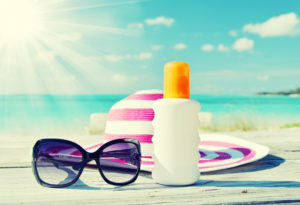Choosing Sunscreen to Protect Against Sun Exposure
With summer here, it’s time to understand the benefits of sunscreen. The reason for sunscreen is that the sun emits two harmful types of ultraviolet (UV) rays: UVA and UBA, which both lead to increased risk of skin cancer. Exposure to UVA rays has also been known to cause wrinkles. Research from the Environmental Protection Agency has established that up to 90% of skin changes from aging is actually caused by your skin’s exposure to UVA rays throughout your lifetime. Thus, limiting exposure by using sunscreen will help prevent signs of aging.
Dermatologists recommend a sun protection factor (SPF) of 15 or higher. Anyone with fair skin or a history of skin cancer should opt for SPF 30 or higher. While choosing a product with a high SPF is a good start, it’s important to understand that SPF only protects against UVB rays. In order to find coverage against UVB and UVA, look for products that are called “broad-spectrum sunscreens,” as these products include additional protection from UVA. There is no rating system to assess how well a sunscreen will block UVA rays, so reading the list of ingredients is key. To project against UVA rays, choose a product with any of the following ingredients: ecamsule, avobenzone, oxybenzone, titanium dioxide, sulisobenzone, or zinc oxide.
Another important consideration is the impact the sunscreen’s ingredients have on the environment, especially if swimming in the ocean due to fragile coral reefs. Some beaches in Hawaii and Florida ban sunscreens that contain certain chemicals such as octocrylene, oxybenzone, and octinoxate. When looking for eco-friendly options consider buying a mineral-based sunscreen with “non-nanotized” zinc oxide or titanium dioxide. While mineral-based products are not as effective at blocking UV rays, they still can offer decent coverage. A good compromise for maximum protection and environmental awareness would be to select an oxybenzone-free chemical sunscreen. Oxybenzone is a chemical known for environmental damage.
Once you have selected a broad-spectrum sunscreen with an SPF of 15+, be sure to apply it 15 to 30 minutes before sun exposure. Typically, one ounce (roughly two tablespoons) will be enough to cover the body. It’s important to apply an even and consistent layer. Regardless of how long the sunscreen is supposed to last, it’s best to reapply every two hours (more if you are exercising or swimming). Be sure to wear sunscreen on cloudy days, as well as sunny ones, as clouds do not stop UV rays. Pay attention to expiration dates, as sunscreen loses effectiveness over time. While sunscreen is a good first defense, no sunscreen can fully protect 100% against UV rays. In addition to wearing sunscreen: opt for shade when possible, wear hats and sunglasses, and aim to void the sun’s most intense hours from 10 a.m. to 4 p.m.

